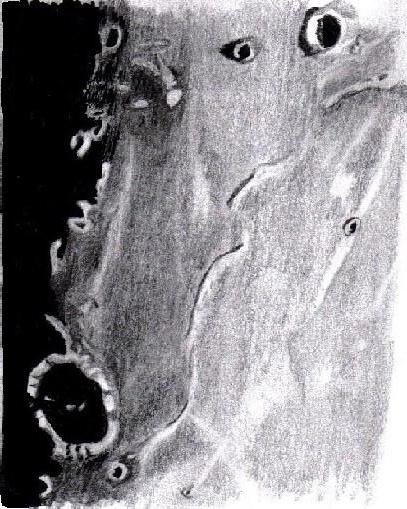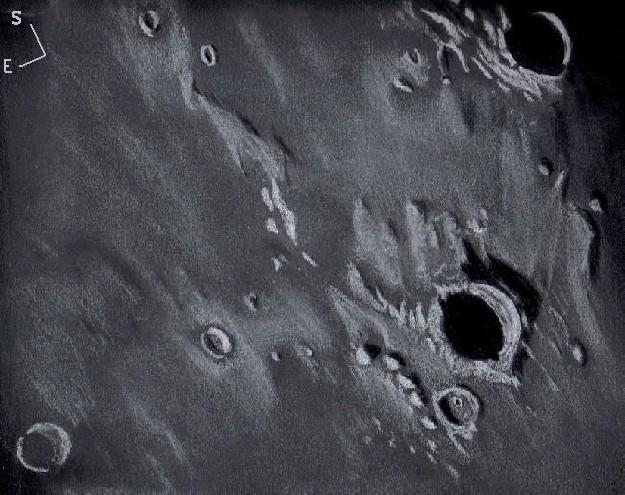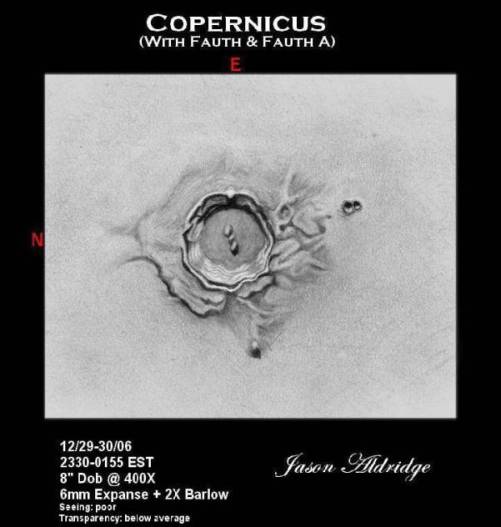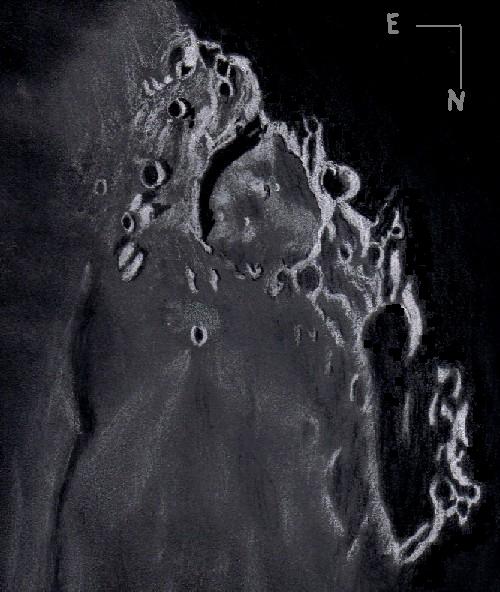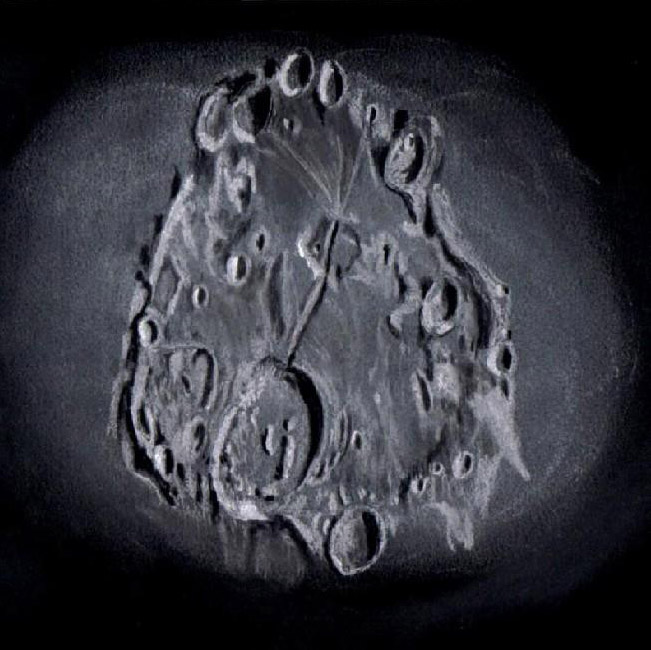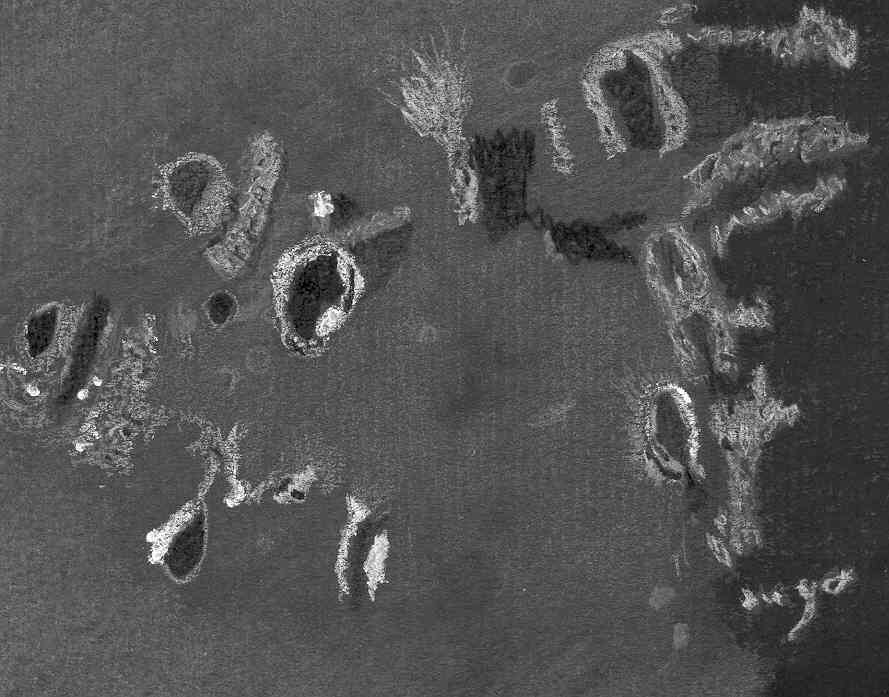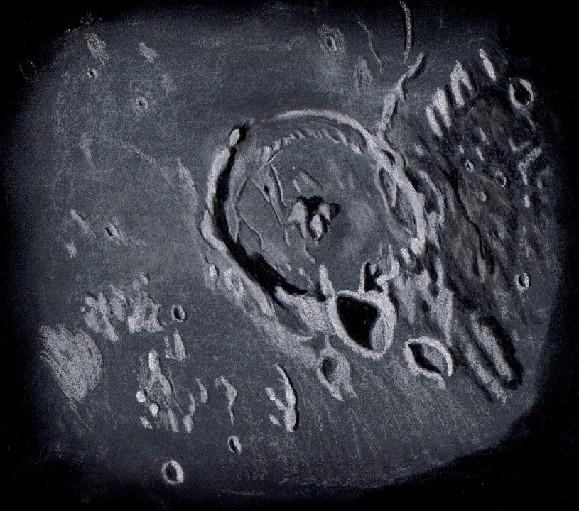On this night I watched the sunset terminator move slowly toward ring-plain crater
Posidonius while I sketched the crater and nearby features on the floor of 750 km.
diameter Mare Serenitatis. Posidonius (99km.) is an old upper Imbrian era impact
reminant. Its age is betrayed by the way shadows penetrate the rim at numerous
points as the sun continued to set. The highest part of the rim is on the
terminator side of this crater. Sunlight was still reaching part of Posidonius A
and two other high points on ridges including one on the inner ring. Beyond this
crater to the west and south the great serpentine ridge could be seen in best
light. This ridge is made up of dorsa Smirnov and dorsa Lister just north of
crater Plinius (44 km.). Smaller and younger crater Dawes (19km.) could be seen
casting a shadow eastward which was growing in length throughout the sketch
interval.
Sketching:
2H graphite pencil, black felt tip marker on white copy paper, gum eraser
Date: 12-10-2006 8:05 to 8:40 UT
10 inch f / 5.7 Dobsonian 9mm ortho ocular 161X
Temperature: 3°C (37° F)
Clear, calm
Antoniadi: III-IV
Colongitude: 150.1°
Lunation: 19.4 days
Illumination: 71.2 %
Frank McCabe
Category: Moon
Craters on the Sea of Islands
Before sunset when I set up to sketch, the wind was howling out of the southwest.
The atmospheric disturbance continued through the nighttime hours and the seeing
remained poor all night. However, the sky was transparent and I set up in a part
of my yard that was most sheltered from the strongest wind gusts.
I selected for sketching the craters on the floor of the lower Imbrian epoch Mare
Insularum. Basin ejecta debris could be seen strewn across much of the floor of
this sea.
From southwest at the terminator is sharp rimmed, upper Imbrian crater Lansberg
(39 km.) totally shadow filled. Further to the northeast about 120 km. is
Eratosthenian aged crater Reinhold (48 km.). With some difficulty I was able to
make out some wall terracing on the western inner slope. A somewhat narrow rampart
was visible around the outer crater rim. East of Reinhold a short distance are the
craters Reinhold B (26 km.) with its flat floor and on its flat floor little
Reinhold A (4 km.) difficult to see most of this observation. On further to the
east the youngest crater in this sketch is 12 km. Gambart A. Some of its ejecta
were brightly visible superimposed on the maria’s darker lava. At the extreme
eastern corner of the sketch is old crater Gambart (25 km.) about the same size as
Reinhold A and like its twin, flat floored, shallow and lacking a central peak
which is uncharacteristic for craters in this size range.
Sketching
For this sketch I used: black Strathmore 400 Artagain paper, 9”x12”, white and
black Conte’ pastel pencils and a blending stump. Brightness was slightly
decreased after scanning.
Telescope: 10 inch f/ 5.7 Dobsonian 6mm eyepiece 241x
Date: 10-21-2007 0:05-1:40 UT
Temperature: 16°C (62°F)
Clear, very windy (30 mph)
Transparency good
Seeing: Antoniadi IV
Co longitude: 27.3°
Lunation: 9.8 days
Illumination: 66.9 %
Frank McCabe
A New Dawn across the Bay of Rainbows
Northwest of the Sea of Rains is the 260 km. crater known as the Bay of Rainbows.
At the time of this evening observation the shadow of the terminator was crossing
the bay beyond 4 km. Heraclides E. A good one third of the bay floor was in
darkness but already Promontorium Heraclides and much taller Promontorium Laplace
across the bay were basking in the morning sunlight. A long triangular shadow from
the latter was seen extending westward. The sunlight was also descending the walls
of what remains of the crater rim known as the Jura mountains. My drawing does not
begin to capture the beauty of this view. East of the bay in the brightly
illuminated Imbrium basin are craters LeVerrier and Helicon both about 20 km. in
diameter. South of this pair are the much smaller craters Carlini and Carlini A.
Sketching
For this sketch I used: White copy paper, 6”x 9”, 2H graphite pencil and an ink
pen. Brightness was slightly increased after scanning.
Telescope: 10 inch f/ 5.7 Dobsonian 12mm eyepiece 121x
Date: 9-3-2006 0:30-1:15 UT
Temperature: 20°C (68°F)
Clear, calm
Seeing: Pickering 5/10
Colongitude: 32.4°
Lunation: 10.2 days
Illumination: 71 %
Frank McCabe
Deep Southern Sea
Southwestern Mare Humorum
Mare Humorum is a small circular sea on the southwestern side of the visible lunar
surface. The thick floor is intermediate in age between the Nectarian and Imbrian
basins. This sketch is focused on the southern perimeter of Humorum and includes
from west to east craters: Doppelmayer (66 km.); Lee (43 km.); Vitello (43 km.)
the youngest and only one of the three with a complete rim. The ghost-like nearly
lava buried crater Puiseux (25 km.) can be seen north of Lee on the floor of Mare
Humorum. Rupes Kelvin and Promontorium Kelvin are both visible east and north of
crater Vitello. I made this sketch while evaluating the performance of a 6” f /7.9
Newtonian telescope.
Sketching:
Date and Time November 2, 2006 1:30-2:30 UT
8.5” x11” copy paper, 2 HB graphite pencil, black ink marker pen
10.8 day old waxing gibbous moon
Colongitude: 45.7°
Illumination: 84 %
Seeing: Pickering 4/10
6” f 7.9 Dob. 6mm ocular 200x
Frank McCabe
Crater Perfection
To me, Copernicus is the perfect crater. It is large enough to see plenty of detail
with smaller telescopes. It’s terraced inner walls, central mountains, and
surrounding landscape are a lunar sketcher’s dream.
This sketch was done on Strathmore Windpower sketch paper with a 2HB mechanical
pencil. Post processing was done with MGI Photosuite III.
Jason Aldridge
North Port, Florida
The Compelling Late Old Moon
South is up and west is to the left in this sketch I made this morning near
daybreak of day 27 for lunation 1048. I knew the view would be poor because I
could not wait at all for the scope’s primary mirror to cool down. Therefore I
kept the magnification low and decided to sketch the compelling region from the
Ocean Procellarum to Sinus Roris. At the top of the sketch closest to the lunar
equator and near the terminator, you can see crater Reiner a 53 km. crater and to
the west of this crater is the famous bright feature Reiner Gamma. Crater Olbers
responsible for the rays in the region is lost in the bright area near the limb.
Most of the craters in this late lunation have floors in darkness and look quite
spectacular through the eyepiece. The longest bright ray from south to north
passes east of the crater pair Cardanus and Krafft both about 50 km. in diameter.
On northward a couple of hundred kilometers and just west of the bright ray the
dark crater Seleucus can be seen and further along to the east of the ray lies Schiaparelli. Most of the remaining craters visible lie on the limb side of the continuing ray and include: large crater Russell (105 km.) with smaller Briggs and Briggs A just to the east.
Continuing on northward across the dark smooth ocean, craters Lichtenberg and
larger Lavoisier A can be seen. At this point the bright limb highlands feature
Harding and Dechen showing bright ejecta blankets near the edge of Sinus Roris. On
the terminator side dome complex Mons Rumker is about to experience sunset.
Finally at the far northern end of the sketch is Markov a 40 km crater on the
floor of Sinus Roris. Seeing the moon early in the morning late in a lunation is
always a pleasant and memorable sight.
Sketching:
For this sketch I used: black Strathmore 400 Artagain paper 12”x 7”, white and
black Conte’ pastel pencils a blending stump and my index finger too. Brightness
was slightly adjusted after scanning.
Telescope: 10” inch f/ 5.7 Dobsonian and 21mm eyepiece 69x
Date: 10-8-2007 10:30-11:15 UT
Temperature: 22° C (72° F)
Clear, calm
Seeing: Antoniadi III
Colongitude: 234.1 °
Lunation: 27 days
Illumination: 7 %
Frank McCabe
A tilted cup
Walled Plain Crater Fracastorius
Lunation day five has walled plain crater Fracastorius (124 km.) basking in the
morning sunlight on the south edge of Mare Nectaris as it has each lunar orbit
for more than three and three quarter billion years. The shallow plate shaped
basin that Fracastorius rests upon subsided from accumulated lava mass and this
over time tilted the crater toward the center of the basin. Eventually the lava
building up in the basin was able to find a breach in the low tilted north wall of
the crater and continued to flow in hiding the central peak and most of the north
wall beyond the breach. Some of the floor of Fracastorius is covered by lavas that
are lighter in color than the dark lava covering most of the Sea of Nectar.
Northward out into Mare Nectaris is the much younger, small (12 km.) bright rimmed
crater Rosse standing alone in this part of the lava sea.
Sketching:
For this sketch I used: black Strathmore 400 Artagain paper, white and black Conte’
pastel pencils and a blending stump. Contrast was slightly adjusted after scanning.
Telescope: 10 inch f/ 5.7 Dobsonian and 6 mm eyepiece 241X
Date: 5-22-2007 1:09-2:15 UT
Temperature: 22° C ( 72° F)
High thin clouds, calm
Seeing: Antoniadi III
Colongitude 331.8 °
Lunation 5.24 days
Illumination 32 %
Frank McCabe
Janssen and Fabricius in the Lunar Southeast
Janssen at 195 kilometers in diameter is a large ancient (4 billion year old)
walled plain crater in the southeastern highlands and is not far from the lunar
limb. Relentless moonquakes and solar system debris impacts have given this crater
its old look. The floor of Janssen is covered by numerous smaller craters. Without
trying too hard I could see 20 crater including those down to a few kilometers in
diameter. The center of the crater appears to bulge higher than the worn rim. Much
of this could be debris from the large much younger impact crater Fabricius (79
km.). Fabricius is an Eratosthenian period impact crater. It clearly shows steep
sloping walls and exhibits a central mountain range that is about 11 km. long and
also a long central ridge that is more than twice that length. Geologists tell us
that much of the debris across the floor of Janssen is Nectaris impact ejecta;
fluidized where the floor is smooth and irregular boulder-like where the floor
appears tortured. But perhaps the most interesting feature here is 140 kilometer long Rimae
Janssen. This rille looking like a graben, where it cuts through the high central
region south of Fabricius. It then narrows suddenly before reaching the rim in the
relatively smooth region of the floor. Pits that are visible via high resolution
images in these narrow regions imply volcanism. There is at least one dome on the
floor of Janssen but I was not successful in spotting it in the current
illumination. Craters Janssen and Fabricius presented fascinating features to
examine during this observation.
Sketching:
For this sketch I used: black Strathmore 400 Artagain paper, 7”x11”, white and
black Conte’ pastel pencils and a blending stump. Brightness was slightly decreased after
scanning.
Telescope: 10 inch f/ 5.7 Dobsonian and 6mm eyepiece 241x
Date: 9-29-2007 6:15-7:15 UT
Temperature: 16°C (60°F)
Clear, calm
Seeing: Antoniadi III
Co longitude: 122.1°
Lunation: 17.73 days
Illumination: 91.4 %
Frank McCabe
Like a Tart
“She appears like a tart that my cooke made me last weeke, here a vaine of bright
stuffe, and there of darke, and so confusedlie all over. I must confess I can see
none of this without my cylinder”.
These were the honest words of William Lower an amateur astronomer written upon
observing the Moon with his new “perspective cylinder” in 1608.
In the history of Man Kind this is but a heart beat in time but how the telescope
has evolved from that primitive Galilean spy glass that only the privileged few
could ever hope to own! Now even the most modest instrument delivers views of the
heavens and Moon in particular that our astronomical forefathers could only have
dreamt of!
One thing that hasn’t changed for me and countless others is the “confusedlie” of
the Moon. It is an awe-inspiring yet bewildering sight to all but the most
experienced lunar observer. I myself am very much a Lunar apprentice and each time
I fly over the terminator with my telescope and settle upon “she who takes my
heart” I am learning my way around not only the shadows, bright ridges and crater
rims but through my post sketch research feature names, dimensions and geological
composition.
On the late evening my visual voyage of 250,000 miles at the eyepieces of my
binoviewer was just such an adventure.
I deliberately selected a relatively demure region, shunning the bright and large
craters in a deliberate attempt to stray from the well trodden path.
It turns out that my target area turned out to be Lacus Exellentiae. I was
initially drawn to a crater with a brightly lit rim just to the left of centre in
my drawing that my subsequent atlas searches found as being nameless apart from
being marked as (b) in a few of the atlases I own . The crater on the right close
to the terminator however turned out to be Clausius with a diameter of 24km and
was situated close the controlled crash site of the European Smart -1 Lunar
orbiter on September 3rd 2006.
A happy hour spent and no longer so Confusedlie!
Moon 11 days
14″ (350mm) Newtonian 193x
Sketch with Derwent watercolour pencils, Derwent Pastel pencils & conte hard
pastels. Blending stumps used, sketch on lightweight black card.
Finished worked scanned but un processed.
Dale Holt
Chippingdale observatory, Nr Buntingford, Hertfordshire UK
A Lunar Favorite
Gassendi Crater, a Lunar Favorite
Protruding inside the northern rim of the sea of moisture is the large floor
fractured crater Gassendi. If you close your eyes and try to picture in your mind
a large lunar crater, the image may look something like Gassendi. The 114 km.
walled plain crater is shallow as a result of lava upwelling across the floor
especially toward the east where the highest concentrations of floor fractures are
crisscrossing. The shallow south end is tipped facing the center of Mare Humorum.
The northern end of the crater floor is rubble strewn and hummocky. The eastern
floor sports ridges and small craters in addition to rilles which were clearly
visible in the good seeing of the evening. The southern floor has an irregular
ridge that is parallel to the low rim. The large central peaks (1.2km. high) and
several smaller ones were seen in good relief with sharp black shadows. The deep
crater Gassendi A on the north rim of the larger Gassendi contrasted nicely with
respect to depth.
Shallower and smaller Gassendi B was just north-north-west of A. The rough
highlands around Rimae Mersenius were visible to the west of these three craters
and low hills in the Herigonius region could be seen to the east of Gassendi. Mare
Humorum is estimated to be 3.9 billion years old and Gassendi perhaps 100 million
years younger. If Apollo 17 planners had chosen Gassendi as the last lunar landing
site we would likely know the ages today.
Sketching
For this sketch I used: black Strathmore 400 Artagain paper, 9”x12”, white and
black Conte’ pastel pencils and a blending stump. Brightness was slightly
decreased after scanning.
Telescope: 10 inch f/ 5.7 Dobsonian 6mm eyepiece 241x
Date: 9-23-2007 2:05-3:15 UT
Temperature: 17°C (62°F)
Clear, calm
Seeing: Antoniadi II
Co longitude: 47.5°
Lunation: 11.6 days
Illumination: 82.7 %
Frank McCabe

